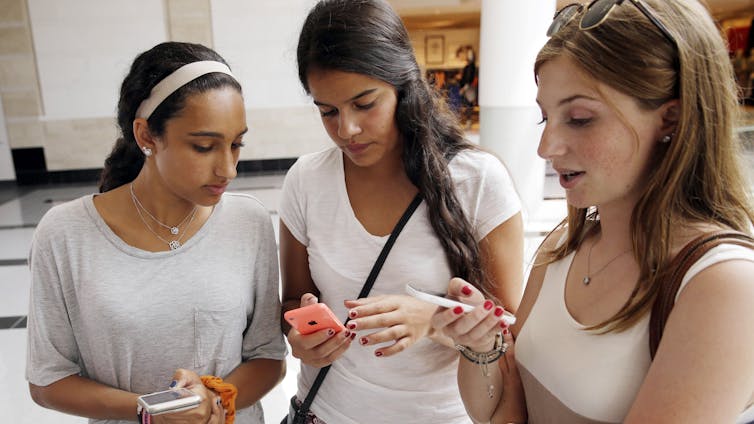Parenting in the digital age can be stressful and demands a lot from parents.
The Family Online Safety Institute (FOSI) recently released its annual Online Safety Survey that discovered almost 50 per cent of parents surveyed aren’t using parental controls to manage their children’s devices. These are tools that would ostensibly help parents filter out inappropriate content or unwanted interactions on their children’s devices.
The FOSI authors conclude the reason parents aren’t using the tools is because they feel “overwhelmed” and recommend parents educate themselves as a good first step toward broader use.
While overwhelm is a real thing, we suggest a bigger problem with parental controls is how they are designed. This includes how little attention is given to supporting open communication between parents and children.
Once a year for the past three years, we’ve asked the same 33 children (initially aged six to 12) what they think about content ratings, online safety, game monetization and privacy.
Our team’s combined expertise in communication, education, policy and game studies analyzed their answers.
We also asked their parents how they mediated their kids’ gaming. Nearly half of them don’t use parental controls either. They say parental controls don’t always work as promised, offer little context about how settings affect gameplay and force binary choices that don’t align with household rules or with children’s maturity levels.
The parents we asked said they aren’t avoiding parental controls because they feel overwhelmed by them. It’s that the tools are poorly designed.
Parent controls can introduce more problems
At the same time, many of the parents described themselves as highly engaged in their child’s gameplay; talking with their children regularly or encouraging play in shared, supervised spaces. Several said they choose to trust their child rather than set top-down limits.
Our findings align with previous research on digital parenting. In one British study, parents said they felt some controls were valuable supplements to mediation, while other controls were poorly designed, introducing more problems than solutions.
The use of parental controls doesn’t necessarily translate to increased child safety. In fact, using parental controls can create a disconnect between parents and children on key safety issues.
(Budi Gustaman/Unsplash)
Awareness of risks
Six children we interviewed were not aware their parents were using controls, and at least two children revealed they didn’t even know why a parent would use parental controls in the first place. In this context, parents’ efforts to protect their children had the unintended side effect of obscuring vital knowledge, leaving the children unaware of some of the key risks associated with playing online. Parental controls can remove opportunities to teach kids about safety if they aren’t part of the conversation.
We believe that the behind-the-scenes protections enabled by (some) parental controls can be detrimental to parent-child communication about online safety. What are the risks? How can children avoid the riskiest behaviour? What should they do when or if they’ve encountered danger?
Meanwhile, parents aren’t always familiar with the features and activities they are asked to restrict or allow. Very few parental controls contain information about how gameplay will be impacted by their settings. Many contain terms only someone familiar with the game would understand, while others are hard to navigate.
All of this can lead to misinterpretations and parent-child conflicts, making the tools even harder to use.
Power of communication
Open communication between parents and children on safety topics fosters trust, which increases the likelihood kids will turn to their parents for help when something dangerous happens.
It enables children to build resiliency, which in turn reduces the risk they’ll be harmed by negative online encounters.
Research also suggests that parent-child communication may be more effective at helping to avoid harm than embedded restrictions enabled by parental controls.

AP Photo/Seth Wenig, File)
The importance of open communication is also emphasized in the FOSI report. In households where conversations about online safety happened regularly (six times or more a year), parents and children were both more likely to view parental controls as a useful and valuable tool for online safety.
This, the authors conclude, “supports the view of online safety as a collaborative effort as opposed to a priority imposed by parents on their children.”
On this point, we couldn’t agree more. Families would benefit from making parental controls and safety settings a family affair. Kids and parents have a lot to learn from each other about the digital world, and reviewing these systems together can provide a much-needed opening for crucial conversations about risk, safety and what kids find meaningful about digital play.
Rethinking safety tools
Let’s not pretend parental controls are a panacea for child safety.
Many parental controls contain serious design flaws and limitations. Very few comprehensively address the needs and concerns of either children or their parents.
Now that lawmakers are starting to make parental controls a mandatory part of new child safety legislation, we urgently need to start taking a closer and more critical look at what they can and can’t do.
Parental controls can be a useful tool when they are designed well, applied with transparency, and provide families with ample options so they can be tailored to not only fit with but foster household rules and open communication.
There’s a lot of work to be done before this is the standard. But also a growing impetus for game and other tech companies to make it happen.

The post “Parental controls on children’s tech devices are out of touch with child’s play” by Sara M. Grimes, Wolfe Chair in Scientific and Technological Literacy and Professor, McGill University was published on 07/06/2025 by theconversation.com





































Leave a Reply